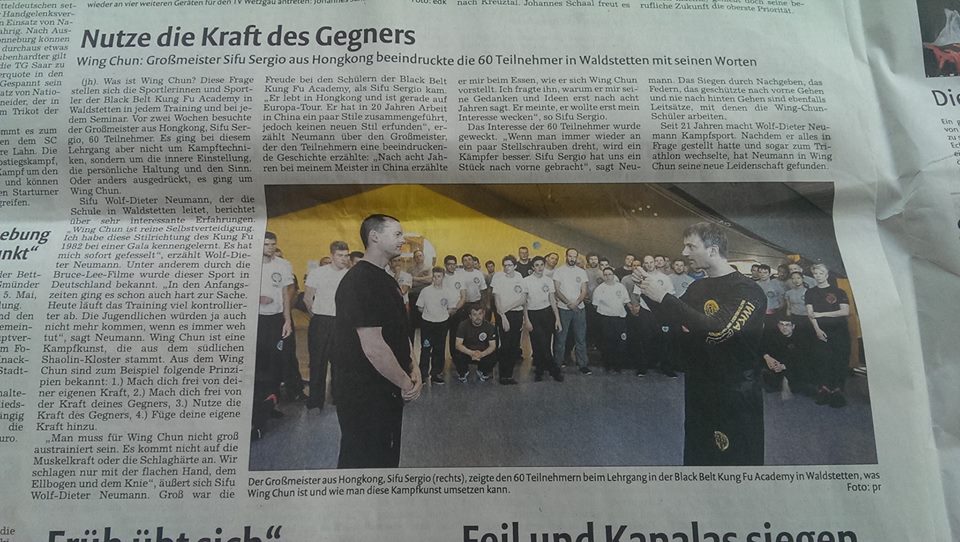Sifu Sergio’s interview in Wing Chun Geeks
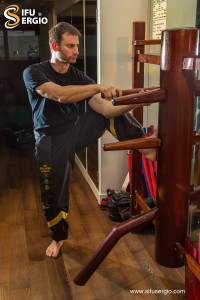
What is the best way to describe what you do? It seems like you fly all over the world documenting Wing Chun styles.
You can sum it up into two parts: I have my IWKA, my Wing Chun association, which is the result of my Wing Chun research. Then my passion is going everywhere interviewing Wing Chun people. A few years ago I decided to share my research on my Youtube channel. I wanted to make it seem like you are coming along with me on my trips. Though my association I am doing my best to pass on this knowledge.
How did you get started with Wing Chun?
In the beginning I was a BIG BIG Bruce Lee fan and I lived in Amsterdam at the time. I came across Wang Kiu, a direct student of Ip Man. Shortly after that I got my hands on a book “Wing Chun Kuen” By Leung Ting. After reading it thought “oh I have to go to a Leung Ting school” and that is how I ended up in that association. I was a part of it from 1988 to 2001 and was deeply involved. I was even the chief instructor of Israel.
Wow, I was under the impression you were pretty closely tied with Emin Boztepe?
There was a period, around 1994-1997; I followed him all around where he held seminars. I got a lot of benefits from my training with him. I got my fighter mentality up and he is a great fighter. I owe him a lot.
What was it like training with someone like him?
At that time there was such a big gap in skill. In my eyes, he was like the second Bruce Lee, just amazing. I respect him a lot. A lot of people who talk crap about him they obviously never touched hands with him.
Did you get to train with Leung Ting as well?
Yes, from 1997/98 I became a private student until the end of 2001. I moved to Hong Kong and had to leave the country every 3 months. I did that by taking the boat to Macao or flying briefly back to Europe. In HK, I lived at a friend’s house across the street from Leung Ting’s school and everyday had private lessons. At the time, I actually had a lot of wealthy Israel students in Amsterdam. They owned hotels and many were private students. I was very lucky, they sponsored my stay in Hong Kong. I trained privately with Leung Ting for one hour everyday for about 4 years. After training we would go Dim Sum and talk about Wing Chun.
What would you talk about at Dim Sum (afternoon brunch and Chinese tea)?
We would sit down and talk, but everyday wasn’t great info. Leung Ting is a very special character, when he is in a bad mood, you’re not getting anything out of him. I would just join him, he would often meet other people. He might be meeting media people and other times I would get to meet famous people, like John Ben who played a mafia boss in “Way Of The Dragon.” Because of this I got to meet lots of interesting people. Sometimes if he was in a good mood, I would ask him quite a bit about Master Ip man, so I learned a lot.
What was it like training with someone, who trained directly under Yip Man?
I had almost finished the system in Europe at the time; we would go over the forms and I would get to do a lot of Chi Sau with him. At night time, I would join the normal class and the instructor classes. That was more training with other people and drilling. That is when I started to take an interest in other schools. In my off time, I would travel around and see other schools.
How would the other schools interpret you stopping by to see what they are training?
I’ve always been a nice guy. I would go in there and they would ask if I trained and where. Of course they would always say “ours is the best,” but the hands talk when you make contact. You learn to feel what is right and what is working. I have to admit, at that time, I thought Leung Ting was the holy grail of Wing Chun. As you know, I did many other lineages afterwards, but I don’t think like that anymore. That being said, it is THE PERSON, not the linage. It is YOU that does the training and YOU that makes it work. If you have two cars, a Fiat and a Ferrari, of course the Ferrair is faster, but if you don’t know how to drive it the Fiat will win the race.
Since you have traveled around a lot and have seen so many different styles and so many interpretations of Wing Chun. One that I found a little surprising is the video of you in Vietnam. He did an applications and I was totally surprised by the result of the applications.
Ah I know the clip you are talking about. There is something I want to make clear. People think, that all the people I interview and all the Sifus I go to are my teachers or I take lesson from them. In reality there are only very few I train with and they accept me as their student. Most people I don’t really agree with, it is something I do for the Wing Chun community, it opens people’s mind to what is out there. To explain the story fully, I have to go back a little bit.
For a while I was studying Yuen Kay San Wing Chun. He was an acquaintance of Grandmaster Ip man at the time, it’s very close to the Ip Man system. His brother immigrated to Vietnam, not only did he practice Wing Chun he also practice Hung Ga, he mixed it together a little. That’s why some of the movements are different. I wanted to compare, how different his brother developed the system. One developed the art in Fut San (the original home of Ip man) and the other in Vietnam.
After meeting all these different people, do you feel a lot of these people are trapped in a bubble? They theorize all these different things and never try it out.
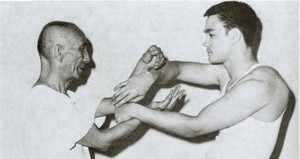 For sure. I was stuck in that bubble! From 1989 to 2001 I was really stuck in the Leung Ting system. I would shut other people down when they would talk about other systems and that’s all there is. Only when I went to China, after I completed the Leung Ting system. I found that I didn’t have the Holy Grail, there are actually other lineages out there that are really special and really good. I learned you really have to open yourself up and become a student again. Not only because these guys trained harder and were just better, but the principles and concept, really made a difference in my Wing Chun the moment I learned them.
For sure. I was stuck in that bubble! From 1989 to 2001 I was really stuck in the Leung Ting system. I would shut other people down when they would talk about other systems and that’s all there is. Only when I went to China, after I completed the Leung Ting system. I found that I didn’t have the Holy Grail, there are actually other lineages out there that are really special and really good. I learned you really have to open yourself up and become a student again. Not only because these guys trained harder and were just better, but the principles and concept, really made a difference in my Wing Chun the moment I learned them.
After an experience like that you have to say “wow, I was stuck in a box.” It was hard to go out of that box, but when I did, my Wing Chun improved A LOT. Now, my students all over the world benefit tremendously from my research. They have the privilege to learn Wing Chun in a much purer form. Many people think “oh this guy is mixing everything together and doesn’t know what he is doing.” Here is a very important point I want to stress. People think they are talking about the PURE Ip man lineage, but they actually have no idea what they are talking about. This is because Ip Man Wing Chun is a mix of several lineages.
At the age of 9 Ip Man started to learn Wing Chun from Chun Wah Sun, but he died when Ip man was only 11. What did Ip man learn from him? As a young kid in only 2 years time? Not much, I think you would agree. He continued his studies with his SiHings (Kung fu older brothers), including Chun Yu Ming, Chun Wah Sun son, Chun Yu Ming. He trained with him until he was around the age of 16. It wasn’t until he met Yuen Kay San that he really started to learn. It is believed that he exchanged with him, but according to my research, he actually LEARNED more than he exchanged from him. Many people out there think I am a Yuen Kay San person, but I’m not, it’s just a fact. Later he went to Hong Kong, in the late 1940’s/1950’s. He studied with people like Chu Chong Man, Tang Yick, from this experience he improved his system again. For example, he taught the wooden dummy. During one time period de taught 146 movements, at a different period of time he taught 108 movements, later 116.
You have all these students of Ip Man saying “he taught me this one” or another saying “no, this one is the authentic one.” Actually, they are all right, he taught all these different versions. This is because he was always tweaking his system. If people talk about “authentic Ip Man wing Chun,” what is “authentic Ip Man wing Chun?” It is a mix of Chen Wah Sun, Yun Kay San, Dai Dak Lan Wing Chun.
From what I understand as he got older, he changed the system. For example he changed for a 50/50 weight stance (50% of your body weight on one leg and 50% on the other) to a stance where the majority of his body weight was on his back leg.
Yea, exactly. Not only that but what is important is also the preservation of “real Chinese culture.” For example, When he was still in China he did not learn the Dai Dak Lan Wing Chun, the first time he learned it was in Hong Kong. Which is the Long pole techniques, which he learned one section of a form that has 18 different sections. After he died it became the “official long pole form. I
n my opinion it is sad; the original form is so much longer. It means because of the fame of one man, Wing Chun just lost a piece of the system. Let’s not forget no matter how good Grandmaster Ip Man was, he would not of become so famous if it was not for Bruce Lee. Of course we have to be grateful for that, because with Grandmaster Ip Man Wing Chun never would have spread as quickly throughout the west. But then again, next to him there are many other really good people who deserve to be seen as Grandmasters. Like Grandmaster Chu Chong Man, Grand Master Tang Yick, Grandmaster Yuen Kay San .
There were so many who did not become famous because they did not have a Bruce Lee story behind it. What happen in the west is that Ip Man Wing Chun became seen as “Wing Chun.” That is why through my research and Youtube channel I want to show the world that yes his Wing Chun is great, but it is only a PART of Wing Chun. It is Ip Man’s personal interpretation of Wing Chun, it is what he had access to. Wing Chun overall is a much broader system. It makes me sad sometimes that people say that the Wing Chun system has Sil Lim Tao, Chum Kiu, Bil Jee, long pole, and the knife. Nooo, some other lineages have more forms. Because Ip Man never learned it, other lineages have Qi Gong forms that the Ip man linage is lacking. If we just look at Ip Man Wing Chun and forget about the rest, we just erased a whole part of Chinese culture.
To your knowledge, are there any other weapon forms?
No. The moment it became known as Wing Chun it has always been the pole and the knives. Some people out there claim it has other weapons, but that was a really long time ago. We would have to really look at the origins of Wing Chun, go to Fujian province, and see if we can find some other weapons. In my opinion, if we look at legitimately when it became known as Wing Chun, only the long pole and the knives.
When you travel around the world, Chi Sau, does it even exists? Does it change from place to place?
The framework changes. If you look at the Leung Ting Wing Chun, it’s very systemized with sections. The problem with that is people get stuck in these sections and become robots. The good thing about it is when you have large groups of people you can systemize it, you can teach large groups of people. You also know which level has what section; it makes sure you get each part. In (mainland) China it’s not that organized.
They teach Chi Sau as a free exercise. Depending on how long you are with the Sifu, what he/she prefers to teach to you is what you will learn. Moves like pon sau, like that famous picture with Bruce Lee and Ip Man. Only in Yuen Kay San and Ip Man system where this position is found. There is another framework in which the other families in China use. They role their arms around in a circler fashion.
This is the original way Wing Chun started their training, which is also found in the White Crane system. According to my research, Fung Siu Ching, he is most likely, the inventor of Poon sau, the more popular way to train Chi Sau today. Ip Man taught this system to so many different students, who opened schools around the world and it became known as standard Wing Chun.
From what I have seen on the internet, many of the other styles look more like Tai Chi push hands, but they throw in a Tan Sau or other Wing Chun moves.
Yea for sure. If you look at the Vietnamese Wing Chun they are very wide in their movements. It looks similar to Tai Chi push hands. I really thing that’s because Yun Chai Wan knowledge wasn’t as profound as his brother in Chi Sau. In my opinion, many Wing Chun lineages are going to far away from the original Wing Chun concept. Which is economy of movement and based on time/space energy. We don’t have a flying kick in Wing Chun because it costs too much time, too much space, and too much energy.
I noticed in many Vietnamese lineages they tend to bend over a bit more.
Yes, many of them do. I also noticed my original Sifu did something similar. I asked him “is this the way you learned it from Ip Man” and he said “yes.” Obviously later on in his teaching career he changed it or thought it wasn’t a good idea to do that.
What do you believe the reason why they bend over so much? T
hey say it adds a lot force to the elbow strike, although I don’t personally agree with it. I think it really exposes you and you break your own centerline.
Before we hit the record button you said you opened up a school in Hong Kong. What was it like opening a Kung Fu school in Asia?
First of all, the people here in Hong Kong are crazy about western sports. Including Karate and Japanese things. MMA and Thai boxing are very popular. Funny enough, many people don’t like Kung Fu. There isn’t a Wing Chun school in Hong Kong that is very successful, like some schools in Europe. I was told by lots of people, a “white devil” (foreigner) there is no way I am going to make it and others have tried and failed. So far, it’s working fine. It is not my biggest school, at the moment I have around 88 students here in Hong Kong.The school is about 75% expats (foreigners who work in HK) and the rest are locals. Which is hard because you only teach people for a few years then they have to go back to their home country. It is hard, you put so much effort into making them better. I didn’t experience that in Europe. They don’t leave because their boss tells them to.
Now that you have traveled all over the world, where do you have to go to learn Wing Chun?
Many people are of the opinion that you can find the “best” Wing Chun in the West. I have to agree in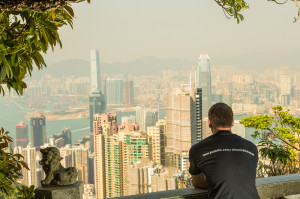 one way, many people in Europe train harder. They really train to fight. Even with less knowledge, they are better. They train harder and more realistically. From my experience I learned most of my real Wing Chun in Hong Kong and China. I studied with Sifu Sunny So, I would see him in Europe and I would invite him to come to teach seminars. It was only after living in Hong Kong and seeing him 2-3 times a week, having dinner with him and talking. That is when he started to slowly open up. Only a year ago I finally learned the final steps of his system. Many people think they can fly to Hong Kong , go to some Chinese Sifu, get a few lessons, and they think that they really learned the whole system. They don’t understand the Chinese way of thinking is quite different. I really think to learn the Wing Chun system completely, you have to go to Hong Kong. That being said, let’s take the Wong Shun Leung linage for an example. I’m 100% sure you can learn the whole Wong Shun Leung system from Sifu David Peterson.
one way, many people in Europe train harder. They really train to fight. Even with less knowledge, they are better. They train harder and more realistically. From my experience I learned most of my real Wing Chun in Hong Kong and China. I studied with Sifu Sunny So, I would see him in Europe and I would invite him to come to teach seminars. It was only after living in Hong Kong and seeing him 2-3 times a week, having dinner with him and talking. That is when he started to slowly open up. Only a year ago I finally learned the final steps of his system. Many people think they can fly to Hong Kong , go to some Chinese Sifu, get a few lessons, and they think that they really learned the whole system. They don’t understand the Chinese way of thinking is quite different. I really think to learn the Wing Chun system completely, you have to go to Hong Kong. That being said, let’s take the Wong Shun Leung linage for an example. I’m 100% sure you can learn the whole Wong Shun Leung system from Sifu David Peterson.
Do you think you still really have to travel to Asia or place that are kind of in the middle of nowhere to learn good Kung Fu, or can you kind of stuck to bigger cities?
Yea sure, but you have to put a little more effort into it. For example I wanted to learn a certain part of Gu Lo Wing Chun. Here in Hong Kong I just didn’t manage. I had to travel to Gu Lo village around 4 times, with translators, and one time I even stayed for few weeks. All this to stay for one piece for the style. Sometimes you really have to go out of your way to get that knowledge.
Questions From Our Facebook Fan Page:
Do you make your students learn more than one different form?
Its very simple, the Yip Man linage is the most famous. We teach that first so you get an overview of Wing Chun. Then we have our unique IWAK Sil Lim Tao, which I wanted to be the most authentic way in my opinion to learn it. We will perform this form with different elements, so the water way, the earth way, the fire way, etc. We teach two, but I can personally perform about 6 different versions of Sil Lim Tao (the first form.) First I really drill people with footwork and basic hand drills. After a few months you would learn other forms, many of which is from other Wing Chun styles. For example we teach the Sup Yai sau (11 hands form) which is older than any of the other Wing Chun forms and precedes many of the Sil Lim Tao forms we know today. The IWKA Wing Chun system is a little bit broader, It has more stuff to it than just classical Ip Man Wing Chun.
What value do you think the knives and pole have in today’s gun world?
Of course we don’t walk around with the pole, but through pole training we can improve certain movements, like your Bong Sau. From the point of view of angles and shapes. On another level it improves your tendon power and expression of energy in the empty hands. Not to mention training with weapons gives you a whole different mindset. It makes you much more focused and much more awake. If you make a mistake with weapons during sparing or whatever, you are in a line of pain. Your whole mindset becomes different. With the knives, your angles improve, your empty hands becomes better. I’m really convinced training the knives improves your hands a lot.
A question from Mike: To my mind, MMA has shown the importance of strength and conditioning. Not every guy is going to lay down and die after a few punches. The power, speed and intensity of attacks in MMA seems much more challenging than the old school “Beimo” matches of old. Ask Sergio how the rise of MMA has changed his view of wing chun. Does he think MMA brings out any weaknesses in the wing chun approach? Why haven’t we seen even a HINT of wing chun working in the UFC? Too much investment in technique and philosophy over conditioning and power? Curious about his point of view.
It’s an interesting question, there are a lot of different engines. I once explained in an article from Wing Chun Illustrated the different between a throwing engine and a pushing engine. Some Wing Chun they just use different types of energy. Ip Man Wing Chun uses what I call more of a “pushing engine,” which is similar to a western boxing engine. But there are other lineages out there that rely more on tendon and ligament strength to relax. They focus on throwing their fist like an iron ball and the arm is like an iron chain. That is not known to many and it creates a tremendous amount of energy. On the other hand I think Wing Chun is for a different group of people than MMA. Wing Chun is more for the average person. To be able to defend themselves, get more self confident, get some self defense capabilities. I really think the MMA public are different. We are comparing apples to pears. The average person doesn’t want to go into the ring and have a professional MMA fight. The people who only see Wing Chun from the view point of fighting, they got a wake up call with the MMA. Go spar or compare with MMA people who really train. I am very lucky that I did a lot of seminars with Sifu Emin Boztepe, he always had a very realistic view of training in Wing Chun. Without hard training nothing functions.
What type of training would you do with Emin Boztepe?
He has very realistic programs. He trains very hard with this students, in the IWKA that hard type of 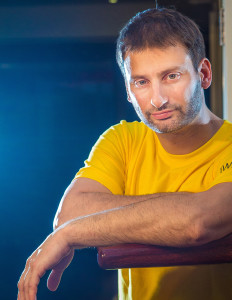 training. We do Chi Sau sparing, we put on the gloves and spar, things like that. We prepair ourselves for the worst and MMA guys. When I lived in Amsterdam I had a lot of friends in the MMA circle and did a lot of training with them. You can’t live in your own bubble. You can’t say “I don’t need to learn anything on the ground because Wing Chun doesn’t have any ground fighting.” Some guys out there can take you to the ground very easily, what happens when you get to the ground? You don’t know anything. That’s why for a few years I studied Brazilian Jiu Jitsu. I wanted to first learn to speak their language, this way I can be sure I know what they are talking about.
training. We do Chi Sau sparing, we put on the gloves and spar, things like that. We prepair ourselves for the worst and MMA guys. When I lived in Amsterdam I had a lot of friends in the MMA circle and did a lot of training with them. You can’t live in your own bubble. You can’t say “I don’t need to learn anything on the ground because Wing Chun doesn’t have any ground fighting.” Some guys out there can take you to the ground very easily, what happens when you get to the ground? You don’t know anything. That’s why for a few years I studied Brazilian Jiu Jitsu. I wanted to first learn to speak their language, this way I can be sure I know what they are talking about.
How did you set up so many schools around the world?
If I go somewhere and have a seminar, if they touch hands or hear what I have to say. Generally they tend to stay. Over the years that is how we spread out naturally, if you look at Italy we have almost 50 schools. I’ve even slowed down; there are several countries that asked me to come. I’m getting older I want to start a family. If I have kids, I don’t want to be away from home. I also have a more relaxed seminar calendar this year, I’m not going to fly out every weekend like I used to do. Now I am only going to go once every few months.
Do you have any final training tips?
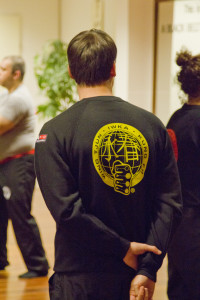 The most important thing with training is do it gradually and make it a habit. People tend to have these bursts of energy where they train very hard and it becomes less less less. Make a schedule with yourself, start off with 15 mins, and do it every day like you brush your teeth. Then build yourself up to 1 ½ to 2 hours a day and when you don’t do it you feel guilty. If you hit that it means you are really into the training. When you train leave all your worries out of it. When you do the training, do it with total concentration and don’t think of anything else. Switch off your phone, switch off your computer, go somewhere no one can disturb you.
The most important thing with training is do it gradually and make it a habit. People tend to have these bursts of energy where they train very hard and it becomes less less less. Make a schedule with yourself, start off with 15 mins, and do it every day like you brush your teeth. Then build yourself up to 1 ½ to 2 hours a day and when you don’t do it you feel guilty. If you hit that it means you are really into the training. When you train leave all your worries out of it. When you do the training, do it with total concentration and don’t think of anything else. Switch off your phone, switch off your computer, go somewhere no one can disturb you.

